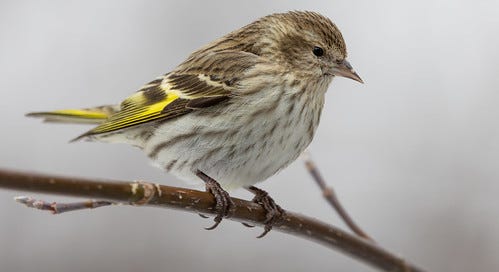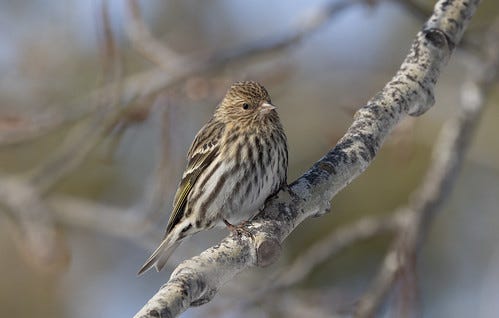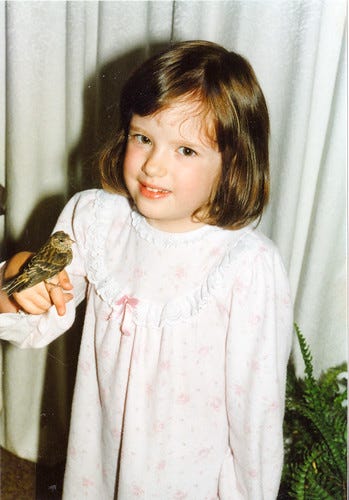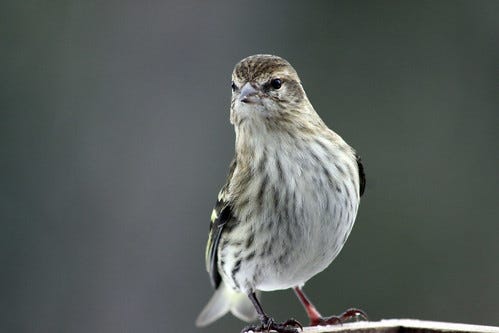Pine Siskin
The "Miss Congeniality" of the finch family, from the general to one special individual.
(Listen to the podcast version of Part 1 here, and Part 2 here.)
I’ve loved birds since I was a toddler, but it wasn’t until I took up birding as a young adult that I realized how very many birds were living all around me that I’d never noticed before. Day after day, month after month, my awareness snowballed.
I’d birded over a year before I saw my first Pine Siskins—a pair of them nesting on the Michigan State University campus. My ornithology professor told us where the easy-to-find nest was on campus, very close to the sidewalk in a tree I’d been passing several times a day that whole term. And the nest was just below my eye-level—how could I possibly have missed it? While I watched, the parents made little twittering sounds—something they must have been doing for at least a couple of weeks as they built the nest, produced their eggs, and now incubated—yet just inches away, I had been utterly oblivious!
Unlike many of their colorful relatives in the finch family, Pine Siskins are easy to overlook. They’re tinier than sparrows with a plain face and very drab plumage. The most colorful individuals may have bright yellow on the wings and/or tail, most easily noticed when they’re in flight, but many show hardly a trace of color. And their un-finch-like slender bill stumps a lot of people—over the years, I’ve heard from a great many radio listeners asking what these little birds could be.
Many of their twittering calls are fairly similar to those of redpolls, but siskins occasionally throw in a rising zzzzzzzz? unique to them. (I set out my sound recorder on February 5 to make this recording.)
In the past couple of weeks, Pine Siskin numbers have soared in my yard. Once in a while I pick out a stray goldfinch, redpoll, or Purple Finch, but often when I sort through as many as 100, every single individual is a Pine Siskin.
I set my phone on my feeder to make this video today (February 7, 2025).
They may never win a beauty contest in competition with other finches, but they’d most certainly be in contention for “Miss Congeniality.” They’re so wonderfully sociable (well, they squabble a bit!) and surprisingly tame that their constant twittering fills me with good cheer even when I’m reeling from the news.
The cleanliness of our feeding stations should always be a higher priority than how many birds we attract.
As winter ebbs into spring, Pine Siskins usually start collecting in even bigger numbers at my feeders, and my maternal instincts rev up, too. Any seed or shells collecting on the ground or in feeders will rot and mold, subjecting these adorable little guys to salmonella, botulism, and other pathogens. Even when temperatures stay below zero for a while, I’m always on red alert in my own yard, and when the snow starts melting, I turn into a mama bear when I notice rotting seeds in other places as well. With the increasing number of mild days in winter due to climate change, raking or shoveling up and disposing of spilled seed has become a regular winter routine rather than the one or two spring cleanings I used to do. The cleanliness of our feeding stations should always be a higher priority than how many birds we attract. During a crisis such as the current epidemic of bird flu, this is absolutely critical.
A True Story about Why I Love Siskins So Much
Watching all the little siskins visiting my feeders makes me very happy, calling to mind one of my most memorable experiences, involving a nestling Pine Siskin who had been attacked by a cat in Duluth in 1989, when I was a newly licensed, still fairly inexperienced wildlife rehabber.
I’d taken a call from someone in West Duluth who “rescued” a baby bird from her cat. The bird was utterly adorable—covered with soft down more like a baby duck than a baby songbird. (I didn’t take any photos of it at first—that would have felt like I was exploiting the poor thing.) I knew it was a finch because they often start nesting during frigid weather, so the nestlings feather out with thick down much more quickly than most songbirds. This one was exquisitely tiny—its feet too small to grasp my baby finger. The tiny size and streaks told me it must be a Pine Siskin.
The bird’s wings were fine, but the cat’s teeth had punctured the poor little thing’s torso, and that first day, large air sacs swelled up beneath the skin on its lower chest. By the third day, the swelling on one side became huge, the bulge holding its right wing askew at an odd angle well above the left. The situation seemed so dire that I kept the tiny thing in my home office and didn’t tell my kids I had it—they were much too little to watch such an adorable creature fade away and die. But I gave it the best chance I could, and the little mite’s eyes stayed bright and it seemed in good spirits despite the ugly wound.
Finch parents regurgitate semi-digested seed to feed their young. Not only did I lack the skills and requisite stomach juices and siskin spit to properly regurgitate seeds, I had even less inclination to try. I experimented with homemade baby bird recipes for a couple of days until I could get to a pet store to buy a hand-feeding mixture for baby cockatiels and parakeets, which I fed using an eyedropper.
Every bird I’d treated after a cat attack ended up dying from internal injuries and horrible infections from the puncture wounds. So the very first day I called every rehabber I knew, trying to find out what antibiotic to use and how to figure out the dosage. The best guess was amoxycillin, the same pink liquid medication my children got for ear infections, supplied by my veterinarian. The best guess anyone could give me on dosage was “one drop several times a day.” The little siskin seemed to like it.
By the fifth day, the swelling on the lower side had gone down, but now it had a new swelling on the side of its neck—a big, bulbous sac that made its breathing labored and its feathers stick out oddly. But it still didn’t seem to be in any discomfort, and even started flitting about, more awkwardly than most fledglings because of the pulsating air sacs, but making it clear that this little bird wanted to stay alive.
It took weeks before the air sacs started receding, and through that time, I didn’t tell my kids about the little bird. But when the air sacs finally disappeared and the punctures were noticeably healing, I finally showed it to them. The boys were still scared of it dying, which had happened with every cat-injured bird I’d taken in before, but my brave little 5-year-old daughter wanted to help me with this bird.
Katie quickly learned how to feed it with the dropper and wanted the bird’s cage in her bedroom. It was the kind of cage with a very large door—Katie kept it wide open from when she woke up in the morning until bedtime. She was good and quick about cleaning up any droppings. Luckily, finch droppings are drier and easier to clean up than those of most songbirds.
After the wounds were entirely healed, Katie started taking the siskin outdoors with her. When she was swinging on our swing set, the little bird sat on her shoulder, fluttering its wings as the swing moved forward and closing the wings when the swing went backwards. And whenever Katie rode her tricycle, she kept her left index finger extended for the little finch to perch on. It seemed to enjoy riding up and down the sidewalk with her as much as she enjoyed riding with it.
In August, more and more finches started gathering in our yard, eating at the feeders and twittering in our spruces, and the siskin started joining them occasionally, but returning to Katie for feedings. But little by little, it figured out, probably from watching the other siskins, how to eat on its own, and it dawned on us that it wasn’t taking nearly as much food from us as it used to. Soon it wasn’t coming down reliably when Katie called. But it always flew to her at day’s end and flew into its cage for the night of its own volition.
Until the night it didn’t come in at all. It wasn’t taking much food from us at all anymore, and clearly could manage life on its own with so many siskins to associate with. Katie and I talked about how important it was for birds to be free and how joyful we felt about that, but releasing a beloved wild bird may be the very situation for which the word ambivalence was coined.
Katie had just started taking piano lessons that summer. The songs in the pre-school book had simple words that the children were supposed to sing as they played to reinforce the melody and rhythm, and that very day she was working on a song called “Little Bird.” There she sat at the piano, her ankles crossed and little legs dangling, tears flowing as she sang, “Little bird, little bird, please don’t fly away. Little bird, little bird, stay and sing all day.” I was crying, too.
The next morning when Russ opened the backdoor to let our dog Bunter go out, in burst the siskin. It flew through the back entry, kitchen, and dining room, turned the corner and headed upstairs, straight into Katie’s room and its cage, where it started swinging maniacally. I have no idea whether something frightened it or if it just needed some time to process the new experience, but it didn’t leave Katie’s side all day, both in and out of the house.
But the next day when it went outside with Katie, it stayed out and never came in again. Katie started all-day kindergarten in September. When she’d get home in the afternoon, the little bird would fly right to her but wouldn’t come in the house when Katie did. Sometimes when she was swinging or riding her tricycle, the siskin would join for a bit, but now it had other friends and things to do.
Then one day it disappeared. It had almost certainly moved on with a siskin flock, but how could we know? Birds never write or call. We waited a week or two before moving the cage out of Katie’s room—she and I both cried.
We thought that was that. But one bright day the following spring, when the snow had cleared and temps were balmy, we brought Katie’s tricycle out to the front sidewalk and she started pedaling down the block. Suddenly, out of the clear blue sky (literally!) a little Pine Siskin dropped down and alighted on my daughter’s finger.
I’ll never know why the siskin did that. Did it miss Katie? Want to thank her and let her know it was fine? Looking out the window, seeing her beaming with joy, the dear little bird on her finger again, remains one of my most beautiful memories. We never saw the little siskin again, or at least never picked it out from other siskins, but even now, 36 years later, I can’t see siskins in my yard without remembering that one beloved little sprite—truly one of my Best Birds EVER!1










Laura, every single one of your essays is such a gem and such a delight. Thank you for brightening our world the way you do.
Katie and you have the most precious memory of that little siskin! And the siskin has of Katie...!